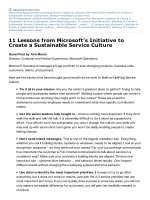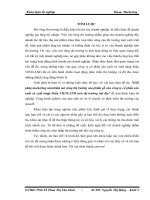From marketing mix to e marketing mix
Bạn đang xem bản rút gọn của tài liệu. Xem và tải ngay bản đầy đủ của tài liệu tại đây (204.97 KB, 17 trang )
From Marketing Mix to E-Marketing
Mix:
a Literature Overview and
Classification
Author: Thang, Tran Duc
Abstract
The marketing mix paradigm, famously known as the 4 Ps, has been extensively discussed in both
academic literature and managerial practice, evolving alongside marketing theory. While the 4 Ps
marketing mix is undeniably a cornerstone of marketing theory, the changing business landscapes
have necessitated a reevaluation of the "controllable factors" that constitute the marketing mix.
Among these contexts, the digital business environment stands out as the most recent and
demanding, requiring a differentiated approach to the mix. Throughout this evolutionary process,
researchers have been divided into two camps: the "conservatives," who believe the 4 Ps paradigm
can adapt to environmental changes by incorporating new elements within each "P," and the
"revisionists," who argue that the 4 Ps paradigm is outdated and propose alternative frameworks.
This paper aims to elucidate these contrasting approaches to the evolution of the marketing mix by
reviewing pertinent literature on the e-marketing mix, with a specific focus on the development of
marketing mix theory for the digital context.
Keywords: E-marketing, Marketing mix, E-marketing mix
1. Introduction
Since its introduction by Neil Borden in 1953, when he first used the term "marketing mix" during his
speech at the American Marketing Association, the business environment has undergone significant
changes. Jerome McCarthy (1964) later defined the 4 Ps marketing mix as a combination of factors
that managers can utilize to meet market needs. Understanding the origins of the traditional
marketing mix is essential for grasping the differentiation between the "conservatives" and
"revisionists" discussed in this paper.
1.1 Theoretical framework
McCarthy's version of the marketing mix consists of four elements: product, price, place, and
promotion. These four Ps encompass several managerial policies described by Borden (1964),
thereby incorporating additional sub-mixes within each P. According to Kalyanam & McIntyre (2002),
the marketing mix encompasses numerous micro-elements that are grouped to streamline
managerial tasks. The question of whether to extend the traditional mix in the digital context, by
including more elements, or to discard it and develop a new framework, is a matter of feasibility and
practicality (see Figure 1).
Borden (1964) emphasized the need to develop a comprehensive understanding of marketing
programs by formulating twelve essential elements. These elements serve two purposes: 1) creating
a list of crucial components or ingredients that constitute marketing programs, and 2) identifying the
various forces that impact a firm's marketing operations, requiring the marketing manager to adapt
and seek a successful mix or program.
Over time, McCarthy's marketing mix has gained widespread acceptance among managers and
academics, establishing itself as a fundamental component of marketing theory and practice. Its
broad adoption can be attributed to its simplicity, making it a valuable tool for both marketing
decision-making and education (Grönroos, 1994; Yudelson, 1999; Jobber, 2001). Within the
Managerial School of Marketing (MSM) (Sheth et al., 1988), the marketing mix is viewed as an
operational tool to attain marketing objectives, particularly in terms of managing controllable
marketing factors within a competitive environment that is beyond a firm's control (Varaldo, 1996).
The MSM has evolved, encompassing various stages from the marketing concept of the 1970s to the
introduction of Total Quality Management in the 1980s (Yudelson, 1999), and relationship marketing
in the 1990s, to its adaptation to the digital context today, the marketing mix has consistently been a
topic of discussion and debate among both managers and academics.
The impact of changes in the social and economic environment on the marketing mix is undeniable.
These transformations have a profound influence on the competitive landscape, necessitating an
adaptation of the marketing mix. In the digital context, specifically, the original version of the
marketing mix reveals significant limitations and shortcomings.
The 1960s did not foresee the level of customer interaction and communication possibilities that the
Internet has brought about. The original formulation of the 4 Ps was designed for a manufacturingoriented context. However, the inherent adaptability of the 4 Ps framework enables its application in
competitive environments that differ substantially from its original intent. The central question that
this paper seeks to address is: "Can a new set of elements be developed to effectively modify the
traditional mix and align it with the requirements of the digital era?"
Researchers hold two distinct perspectives regarding the modification of the traditional marketing
mix for digital contexts. One group, referred to as the "conservatives," argues that the 4 Ps paradigm
can remain the dominant framework in the digital era. They propose adjusting the sub-mixes within
each P by incorporating or eliminating certain factors to adapt to the new landscape. On the other
hand, another group of authors, known as the "revisionists," contends that the 4 Ps framework has
become outdated. They advocate for the addition of new elements or a complete overhaul of the
mix's components. Both approaches offer compelling justifications to support their respective
conclusions. This paper aims to provide clarity on these motivations by conducting a comprehensive
literature review on the topic.
1.2 Objective and delimitation of research
This study provides a comprehensive literature overview and classification to present an overview of
the ongoing debate regarding the suitability of adopting the traditional marketing mix in digital
environments. Rather than providing a definitive answer, the paper aims to highlight relevant aspects
that should be taken into account in this debate. It is important to note that a key limitation of this
study is its exclusive focus on academic opinions published in research papers and academic
textbooks, without considering practical field experience. Consequently, the paper emphasizes the
necessity for further research on this issue to incorporate insights from real-world implementation
and experiences.
2. New marketing mix for the digital business environment: the
revisionists’ view
the traditional 4 Ps and provides a more specific framework for defining marketing levers. This line of
research, referred to as "revisionist," argues for a fundamental reconceptualization. The primary
critique against the 4 Ps is its internal focus, which leads to a lack of customer orientation and
insufficient emphasis on customer relationships (Möller, 2006; Popovic, 2006; Constantinides, 2002a,
b). Schultz (2001) highlights the need for a new externally oriented paradigm that considers the
network system view in today's marketplaces. Notably, all the reviewed literature in the "revisionist"
e-marketing mix domain emphasizes the importance of explicit customer orientation. This limitation
is relevant to all aspects of modern marketing but has particular significance in Internet marketing,
where interactivity is viewed as a critical factor.
It is interesting to notice that, despite these criticisms, the majority of the “revisionist” authors
reviewed agree to include the 4 Ps in their marketing mix models, with few exceptions.
Lawrence et al. (2000) suggest expanding the traditional 4 Ps of the marketing mix by including two
additional Ps: people and packaging. This expanded mix is then incorporated into a 5 Ps marketing
concept that includes paradox, perspective, paradigm, persuasion, and passion. This proposal has
been a subject of debate in the marketing mix literature for several decades.
In the Italian literature, Prandelli and Verona (2006) propose a 3 Cs model that incorporates key
elements within each C: content (website and platform), community (interaction platform and
relational capability), and commerce (including the traditional 4 Ps: product, price, place, and
promotion).
Another model suggested by Pastore and Vernuccio is the 3C+I (interface) model, where the 4 Ps are
integrated and recontextualized in the online environment. This model takes into account the specific
characteristics of the digital space, as depicted in Figure 2.
These alternative models and frameworks reflect the ongoing efforts to adapt and extend the
traditional marketing mix to address the complexities of the digital era and incorporate the unique
features of online platforms and interactions.
Kalyanam and McIntyre (2002) introduce a comprehensive model called the 4P+P2+C2+S3, which
expands upon the traditional 4 Ps. This model incorporates additional dimensions to provide a more
complete taxonomy of the elements that constitute the marketing mix. The three-dimensional
representation helps capture the complexity of the operative context, as illustrated in Figure 3.
Chen (2006) emphasizes the significance of the environment and interaction in a model proposed by
Chinese researchers from National Taiwan University (1999). This particular model considers 8 Ps,
with four of them aligning with the traditional Ps. Figure 4 represents this expanded framework.
These models showcase the efforts of researchers to incorporate various dimensions and factors into
the marketing mix to address the multifaceted nature of marketing in different contexts. The
inclusion of additional elements and dimensions helps provide a more comprehensive and nuanced
understanding of the marketing mix in relation to specific environments and interactions.
In the 8 Ps’ model
Precision refers to the increased accuracy of the selection process of the target segment and
market positioning in digital contexts, thanks principally to database management systems;
Payment systems must be secure and easy for customers to use;
Personalization concerns the possibility of creating a flexible interface, which can adapt to
customers’ needs and wills;
Push and Pull regard the choice of the trade-off between active communication policies
(push) and communication on users’ demand (pull).
Indeed, some authors argue for a departure from the traditional 4 Ps and propose alternative
marketing mixes that are better suited for the digital era. For example, Chaffey et al. (2000) contend
that the Internet necessitates a reevaluation of the traditional marketing mix. They highlight eight
critical issues that should be considered in strategic-level marketing planning, including audience,
integration, marketing support, brand migration, strategic partnerships, organizational structure, and
budget.
Constantinides (2002a) puts forth the Web Marketing Mix Model, which extends the marketing mix
to strategic and business organization levels. In this model, he suggests a 4S framework that includes
the following elements:
Scope, of strategic relevance, includes strategic objectives, market analysis and potential,
stage of e-commerce maturity, strategic role of e-commerce for the organization;
The site has operational value and involves interface issues;
Synergy has organizational significance including the integration among bricks and clicks
aspects of the company’s business model;
System, concerns the management of the Web platform, the data warehouse and the
security systems.
3. Maintaining the 4 Ps in digital contexts: the conservatives’ view
While acknowledging the need for adjustments in the marketing mix due to the influence of digital
technologies, particularly the Internet, there is a smaller but theoretically consistent body of
literature that argues in favor of the traditional 4 Ps model's adaptability and continued relevance in
these new contexts. Researchers such as Aldridge et al. (1997), Peattie (1997), O'Connor and Galvin
(1997), Bhatt and Emdad (2001), Allen and Fjermestad (2001), and Möller (2006) assert that the 4 Ps
framework is capable of adapting to the changes in society and the market brought about by digital
technologies.
These authors argue that the core principles of product, price, place, and promotion remain essential
components of marketing, even in the digital era. They contend that while adjustments and
considerations may be necessary, the underlying concepts and strategies of the 4 Ps can still
effectively guide marketing efforts and strategies in new contexts.
By emphasizing the continued relevance and adaptability of the 4 Ps model, this perspective
highlights the enduring importance of fundamental marketing principles while recognizing the need
for contextual adjustments in response to technological advancements.
Möller (2006) argues that the criticism of the 4 Ps model as being internally oriented stems from a
misconception about the relationship between the marketing mix and the marketing concept.
According to Möller, the 4 Ps paradigm is entirely consistent with the marketing concept, which
asserts that marketing activities should be founded on the identification of customer needs and
wants. This concept also implies the collection of specific information from customers to effectively
meet their needs through segmentation, product differentiation, and positioning.
Möller contends that the 4 Ps model aligns with the marketing concept by providing a framework for
addressing customer needs. Each of the four elements—product, price, place, and promotion—plays
a crucial role in understanding and fulfilling customer requirements. By utilizing these elements,
marketers can identify and cater to the explicit information necessary to meet customer needs
effectively.
In summary, Möller defends the coherence of the 4 Ps model with the marketing concept,
highlighting how it enables marketers to align their activities with customer requirements through
segmentation, product differentiation, and positioning.
Peattie (1997) highlights the significant impact of digital technologies on marketing across various
sectors, primarily due to their new communicative capabilities. However, Peattie argues that the
marketing mix approach can adapt to these changing needs. For instance, in the product dimension,
co-designing products with customers can be facilitated by digital technologies. In terms of price,
higher levels of transparency can be achieved, enabling customers to make more informed decisions.
The concept of place can be transformed by creating new ways to reach customers through digital
channels. Lastly, promotion can benefit from the interactive capabilities offered by digital
technologies.
Bhatt and Emdad (2001) emphasize the empowerment of the 4 Ps through the internal
transformation brought about by the virtual value chain. They suggest that each of the 4 Ps gains
new dimensions in the digital context. The product dimension incorporates personalized information,
price involves transparency and personalization, place enables direct delivery, and promotion
becomes more flexible.
O'Connor and Galvin (1997) acknowledge the need for the traditional marketing mix paradigm to
evolve in response to the digital landscape. However, they propose that digital technologies can
enhance the functionality of the marketing mix while maintaining the 4 Ps as the fundamental
instruments for Internet marketing.
In summary, these authors recognize the transformative impact of digital technologies on marketing
but argue that the 4 Ps can adapt and evolve to meet the new demands. They suggest incorporating
new dimensions and leveraging the capabilities offered by digital technologies to enhance each
element of the marketing mix for effective Internet marketing.
Among the changes brought to each of the 4 Ps by digital technologies, the following are the most
relevant:
Product: A contemporary redefinition of the product involves considering all the benefits that users
derive from the exchange over time (Yudelson, 1999). This revised definition is applicable in the
digital context, where the Internet's capabilities offer significant advantages for product policies. The
interactive and connective nature of the Internet gives rise to a new concept known as the "virtual
product" (Valdani, 2000; Pastore & Vernuccio, 2004). The virtual product combines tangible and
intangible elements and can be adapted and personalized based on individual preferences, with
active involvement from consumers (von Hippel, 2005; Dominici, 2008b).
In the digital realm, products can be delivered to consumers in digital formats (e.g., mp3 for music,
avi for movies, pdf for books and magazines), allowing for their contextualized consumption within
the digital framework (Pastore & Vagnani, 2000). On the demand side, the ability to access
information plays a crucial role (Smith & Chaffey, 2001). Andreini (2006) highlights the effectiveness
of Nelson's classification (1970), which categorizes products as "search" or "experience." "Search"
products are those for which complete information can be obtained before making a purchase, while
"experience" products lack pre-purchase information or acquiring it may be too costly. The Internet
has greatly facilitated the purchasing process for "search" products by making information readily
available and affordable online. Moreover, with the abundance of information and the interactivity of
Web 2.0, it has become possible to transform "experience" products into "search" products (Klein,
1998; Andreini, 2006).
In summary, the evolving digital landscape has necessitated a broader understanding of the product,
encompassing the long-term benefits derived from the exchange. The Internet's capabilities enable
the development of virtual products that combine tangible and intangible aspects, allowing for
customization and personalization. Additionally, the Internet facilitates the delivery of digital
products and enhances the availability of information, transforming certain products into "search"
products, thereby influencing the purchasing process.
Price: A redefinition of price involves considering everything that the buyer gives in terms of money,
time, and effort to acquire a product (Yudelson, 1999). From the consumer's perspective, the
Internet offers significant benefits in terms of reducing information asymmetries and increasing price
transparency (Bhatt & Emdad, 2001). Consumers can compare prices in real time and make more
informed decisions. Furthermore, the implementation of Artificial Intelligence (AI) agents allows for
automated and customized price and feature comparisons, reducing the time and effort involved in
price assessment (Dominici, 2008a).
On the producer's side, the Internet enables real-time price modifications, which can lead to
potentially detrimental price competition (Allen & Fjermestad, 2001), thereby reducing profit
margins. To mitigate this, online communication needs to focus on emphasizing the qualitative
aspects and differentiation attributes of the product. By highlighting unique value propositions and
product differentiation, producers can steer the conversation away from solely price-based
competition.
In summary, the redefined concept of price encompasses the monetary, temporal, and effort-related
aspects of acquiring a product. The internet empowers consumers by providing real-time price
comparisons and increased transparency. However, producers need to strategically focus on product
differentiation and qualitative aspects to avoid excessive price competition and maintain profit
margins.
Place: Today, place can be defined as encompassing everything that is done and necessary to
facilitate the exchange process (Yudelson, 1999). In the digital context, this definition highlights the
importance of incorporating the element of the purchasing process as a key aspect of place within
the marketing mix. The process should be seamless and user-friendly, while simultaneously fostering
customer relationships. Physical locations are transformed into virtual spaces, incorporating
intangible aspects of the transaction.
Bhatt & Emdad (2001) emphasize that the Internet's main contribution to businesses goes beyond
the mere ability to sell products online. Its true value lies in its capacity to build relationships with
customers. The interactive capabilities of the Internet enable the implementation of more efficient
and effective systems of digital Customer Relationship Management (e-CRM). By registering users on
a company's website and collecting online purchase data for each customer, valuable information can
be obtained. This data can then be utilized to manage customers, maintain service levels, and
enhance customer portfolio management (Fjermestad & Romano, 2003; O'Leary et al., 2004).
In summary, in today's digital landscape, place encompasses all the efforts and processes necessary
to facilitate smooth exchanges. It emphasizes the importance of integrating the purchasing process
and cultivating customer relationships. The virtual nature of online spaces enables businesses to
leverage interactive capabilities and implement effective e-CRM systems, utilizing customer data to
enhance service levels and optimize customer portfolio management.
Promotion: Promotion can be redefined to include all the information transmitted among parties
involved in the exchange process (Yudelson, 1999). This definition encompasses the interactive
aspects of digital communication. The Internet distinguishes itself from other mass communication
media (Morris & Ogan, 1996). While it can effectively reach a large and geographically dispersed
audience, it sets itself apart by offering interactive and multimedia features. Hoffman & Novak (1997)
highlight that in the web environment, the traditional one-to-many communication concept loses its
dominance, and a new many-to-many paradigm emerges. Personal interaction allows for targeted
messaging tailored to specific individuals, providing a level of flexibility unmatched by other media
(Bhatt & Emdad). This capability also enables reaching the target audience when they are in a relaxed
and confident state (referred to as "low involvement" by Krugman, 1965), similar to television
advertising, but with higher informational capabilities due to the multimedia features of web
communication.
The objective of online communication extends beyond advertising products; it aims to build a
purchasing relationship and foster customer trust. Interaction, multimedia, and relationship-building
should be considered as essential elements of the promotion aspect of marketing.
In summary, redefining promotion to include all transmitted information acknowledges the
interactive nature of digital communication. The Internet's unique features allow for personalized
and targeted messaging, fostering engagement and trust. The inclusion of interaction, multimedia,
and relationship-building as integral components of promotion recognizes the evolving dynamics of
online marketing.
4. Conclusions and further research
The 4 Ps marketing mix, originally developed in an era dominated by physical products, physical
distribution, and mass communication, has faced increasing criticism in the face of the new business
environment shaped by the capabilities of digital contexts. Many authors argue that the traditional
marketing mix is outdated and inadequate for the 21st century. While the mix can be adapted to
incorporate a wide range of variables to accommodate changes in the business environment, a
universally accepted replacement for the 4 Ps has yet to emerge after almost half a century.
The ongoing search for a new dominant paradigm for marketing decisions in digital environments
indicates that a widely accepted standard to fully substitute the 4 Ps is still elusive. This lack of a new
model may be due to an incomplete understanding of the full potential of digital technologies for
business and a lack of emphasis on case study research in marketing operations. Online companies
have not yet reached their full maturity, unlike industrial enterprises that were well-established
when the 4 Ps were formulated. Despite the controversies between "conservatives" and
"revisionists," it is evident that the basic framework of the 4 Ps remains valid and serves as the core
of operational decisions, albeit with some extensions and adjustments.
The conservative view suggests the possibility of modifying the elements within each P of the
traditional mix. Borden's (1964) formulation of twelve elements based on empirical evidence and
case histories in the 1960s highlights the need for current research on this topic. As e-marketing
research and practice deepen their understanding and maturity in the digital environment, a new
marketing mix paradigm will likely emerge, relegating the traditional 4 Ps and giving rise to a new
widely accepted framework for marketing operations.
In summary, while the traditional 4 Ps marketing mix has faced criticism and calls for a new
paradigm, a universally accepted replacement has not yet emerged. The ongoing evolution of the
digital landscape and the need for further research and understanding suggest that a new marketing
mix paradigm is still in development. Until then, the 4 Ps, with some modifications, continue to serve
as the foundation for marketing decision-making.
References
Andreini D. (2006). The Evolution of the Theory and Practice of Marketing in Light of Information
Technology, in
Krishnamurthy S. Contemporary Research in E-Marketing, Vol. 2, pp. 168-215.
Borden N.H. (1964). The Concept of the Marketing Mix. Journal of Advertising Research, 24 (4): 7-12.
Bruner G. C. (1988). The marketing mix: A retrospective and evaluation. Journal of Marketing
Education, 10: 29-33.
Chaffey D., Mayer R., Johnston K., Ellis-Chadwick F. (2000). Internet Marketing, Strategy,
Implementation and
Practice, FT/Prentice Hall.
Chen C-Y. (2006). The comparison of structure differences between internet marketing and
traditional marketing.
International Journal of Management and Enterprise Development, 3 (4): 397–417.
Constantinides E. (2006). The Marketing Mix Revisited: Towards the 21st Century Marketing. Journal
of Marketing
Management, 22 (3): 407-438.
Constantinides E. (2002a). The 4S Web-Marketing Mix model. Electronic Commerce Research and
Applications, 1:
57-76.
Constantinides E. (2002b). From Physical Marketing to Web Marketing: The Web-Marketing Mix. atti
della 35th
Hawaii International Conference on System Sciences.
Culliton J. W. (1948). The Management of Marketing Costs, Boston: Division of Research. Graduate
School of
Business Administration, Harvard University.
Dixon D. F., Blois K. J. (1983). Some Limitations of the 4 Ps as a Paradigm of Marketing, in Blois K. J. (a
cura di).
Proceedings of the Marketing Education Group, pp. 92-107.
Dominici G. (2008a). Holonic Production System to Obtain Flexibility for Customer Satisfaction.
Journal of Service
Science and Management, 1 (3): 251-254.
Dominici G. (2008b). Demand Driven Supply Chain ed innovazione: il sistema logistico-produttivo per
la soddisfazione
dei bisogni del cliente in Purpura A. & Fazio G. (ed.), Economia e gestione dell’innovazione nelle PMI.
Percorsi
tematici ed esperienze formative del Master EGI , pp. 100-114, FrancoAngeli.
Dominici G. (2009). E-marketing cosa cambia? Dai modelli di business al mix operativo, Milan:
FrancoAngeli.
E-center of National Taiwan University of Science and Technology. (1999). The Electronic Commerce,
TsangHai Book
Co., pp.2–150.
Fjermestad J., & Romano N. C. J. (2003). An Integrative Implementation Framework for Electronic
Customer
Relationship Management: Revisiting the General Principles of Usability and Resistance, Proceedings
of the 36th
Hawaii International Conference on Systems Sciences.
Goi C.L. (2005). Marketing Mix: a Review of ‘Ps’. Journal of Internet Banking and Commerce, 10 (2).
[Online]
Available: www.arraydev.com/commerce/JIBC/2005-08/goi.htm
Goi C. L. (2009). A review of Marketing Mix: 4Ps or More? International Journal of Marketing Studies,
1 (1): 2-14.
Goldsmith R. E. (1999). The Personalized Marketplace: Beyond the 4Ps. Marketing Intelligence &
Planning, 17 (4):
178-185.
Goldsmith R. E. (2002). Explaining and Predicting Consumer Intention to Purchase over the Internet:
An Exploratory
Study. Journal of Marketing Theory and Practice, 10 (2): 22-28.
Grönroos C. (1994). Quo vadis marketing? Toward a relationship marketing paradigm. Journal of
Marketing
Management, 10 (5): 347- 360.
Grönroos C. (1994b). From Marketing Mix to Relationship Marketing: Towards a Paradigm Shift in
Marketing.
Asia-Australia Marketing Journal, 2 (1): 9-30.
Grönroos C. (2000). Relationship Marketing: The Nordic School Perspective”, in Sheth J. N., Parvatiyar
A. (a cura di),
Handbook of Relationship Marketing, Sage.
Grönroos C. (2005). On defining marketing: finding a new roadmap for marketing. Marketing Theory,
6 (4): 395-417.
Grönroos C. (2008). In Search of a New Logic for Marketing: Foundations of Contemporary Theory,
Wiley.
Hoffman, D.L., & Novak, T.P. (1997). A New Marketing Paradigm for Electronic Commerce. The
Information Society:
An International Journal, 13: 43-54.
Jobber D. (2001). Principles and Practices of Marketing 3rd edition, McGraw Hill.
Kalyanam K., & McIntyre S. (2002). The E-marketing Mix: a Contribution of the E-Tailing Wars.
Academy of
Marketing Science Journal, 30 (4): 487-499.
Klein L. R. (1998). Evaluating the potential of interactive media through a new lens: Search versus
experience goods.
Journal of Business Research, 41: 195-203.
Lambin J. J. (1972). A Computer On-Line Marketing Mix Model. Journal of Marketing Research, 9:
119-126.
Lasswell H. D. (1948). The Structure and Function of Communication in Society, in Bryson L. (a cura
di), The
Communication of Ideas, Harper & Bro.
Lawrence E., Corbitt B., Fisher J. A., Lawrence J., & Tidwell A. (2000). Internet Commerce: Digital
Models for
Business (2nd ed.), Wiley & Sons.
Lauterborn R. (1990). New Marketing Litany: 4Ps Passes; C-Words Take Over, Advertising Age,
ottobre, pp.26-28.
McCharty E.J. (1960). Basic Marketing: A Managerial Approach, Irwin.
McCharty E.J. (1964). Basic Marketing: A Managerial Approach, 2nd ed., Irwin.
McCarthy E. J., & Perreault W.D. Jr. (1987). Basic Marketing: A Global Managerial Approach, Irwin.
Möller K. E. (1994). Interorganizational Marketing Exchange: Metatheoretical Analysis of Current
Research
Approaches, in Laurent G. Lilien G, Pras B. (a cura di), Research Traditions in Marketing, pp. 348-382,
Kluwer.
Möller K. E., & Halinen A. (2000). Relationship Marketing Theory: Its roots and directions. Journal of
Marketing
Management, 16 (1): 29-54.
Möller K. E. (2006). Comment on: The Marketing Mix Revisited: Towards the 21st Century Marketing?
by E.
Constantinides. Journal of Marketing Management, 22 (3): 439-450.
Morris M., & Ogan C. (1996). The Internet as Mass Medium. Journal of Computer-Mediated
Communication, 1 (4),
[Online] Available: html
Mosley-Matchett J. D. (1997). Include the Internet in marketing mix. Marketing News, 31 (25).
Nelson P. (1974). Advertising Information. Journal of Political Economy, 83: 729-754.
O’Learly C., Rao S., & Perry, C. (2004). Improving Customer Relationship Management through
Database/Internet
Marketing. A Theory-building Action Research Project. European Journal of Marketing, 38 (3/4): 238254.
Pastore A., & Vagnani G. (2000). Il ruolo dell’e-commerce nell’evoluzione dei sistemi distributivi.
Industria e
Distribuzione, 1: 33-46.
Pastore A., & Vernuccio M. (2004). Marketing, Innovazione e Tecnologie Digitali. Una lettura in ottica
sistemica,
Padua (IT): Cedam.
Pastore A., & Vernuccio M. (2008). Impresa e comunicazione. Principi e strumenti per il
management. 2a
ed.., Milan:
Apogeo.
Popovic D. (2006). Modelling the marketing of high-tech start-ups. Journal of Targeting,
Measurement and Analysis
for Marketing, 14 (3): 260-276.
Prandelli E., & Verona G. (2006). Marketing in Rete, Milan: McGraw-Hill.
Robins F. (2000). The E-marketing mix. The Marketing Review, 1: 249-274.
Schultz D. E. (2001). Marketers: Bid Farewell to Strategy Based on Old 4Ps. Marketing News, 35 (2): 7.
Vignali C., & Bavies B. J. (1994). The Marketing Mix Redefined and Mapped: Introducing the MIXMAP
Model.
Management Decision, 32 (8): 11-16.
Von Hippel E. (2005). Democratizing innovation, MIT Press.
Wang K.L., Wang Y., & Yao J.T. (2005). A Comparative Study on Marketing Mix Models for Digital
Products.
Internet and Network Economics Proceedings of First International Workshop, WINE 2005, Hong
Kong, China, 15-17
december, pp.660-669, Springer.
Yudelson J. (1999). Adapting McCarthy’s Four P’s for the Twenty-First Century. Journal of Marketing
Education, 21
(1): 60-67.
Appendices









